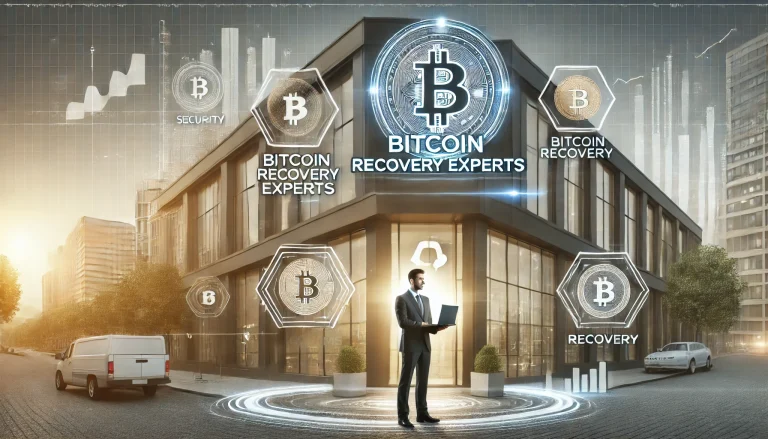Frozen Account Recovery: A Professional Guide to Regaining Access to Your Assets
A frozen account is one of the most disruptive and stressful events an individual or business can face in the financial world. Whether it’s a traditional bank account, a cryptocurrency exchange account, or a payment processor, the sudden loss of access to funds can halt operations and create significant personal hardship.
This article provides a professional overview of why accounts are frozen, the step-by-step process for recovery, and the best practices to prevent it from happening or to resolve it efficiently.
Understanding the Why: Common Reasons for Account Freezes
Financial institutions and platforms freeze accounts primarily to manage risk and comply with regulations. Understanding the trigger is the first step toward resolution. Common reasons include:
-
Suspicious Activity Reports (SARs): The bank or exchange detects transactions that deviate from your typical pattern, appear structured to avoid reporting thresholds (smurfing), or originate from high-risk jurisdictions. This is a requirement under Anti-Money Laundering (AML) regulations.
-
Know Your Customer (KYC) Verification Issues: An expired ID, discrepancies in personal information, or failure to complete a mandatory KYC re-verification process can trigger a freeze.
-
Court Orders or Government Levies: Accounts can be frozen due to a lawsuit judgment, tax levy (e.g., from the IRS), or other legal actions.
-
Security Concerns: The platform suspects unauthorized access or that the account credentials have been compromised, freezing it to protect your assets.
-
Terms of Service Violations: Engaging in prohibited activities, such as using a personal account for commercial purposes, trading prohibited assets, or engaging in arbitrage or trading strategies the platform deems abusive.
The Frozen Account Recovery Process: A Step-by-Step Guide
Resolving a frozen account requires patience, organization, and a professional approach. Follow these steps methodically:
Step 1: Determine the Reason for the Freeze
-
Check Notifications: Immediately review all communication from the institution—email, SMS, and in-app messages. They are legally obligated to provide a reason, though it may be vague (e.g., “security review”).
-
Contact Customer Support: Calmly and clearly inquire about the specific reason for the freeze. Ask exactly what information or action is required to resolve it. Document the name of the representative, the date, and the case number.
Step 2: Gather Required Documentation
This is the most critical phase. Be prepared to provide comprehensive evidence. Commonly requested documents include:
-
Proof of Identity: A government-issued ID (passport, driver’s license), often requiring a recent photo of you holding the ID.
-
Proof of Address: A recent utility bill, bank statement, or lease agreement.
-
Source of Funds (SoF) / Source of Wealth (SoW): This is crucial for larger transactions. Be prepared to provide:
-
For deposits: Bank statements, pay stubs, tax returns, or a letter from an employer.
-
For cryptocurrency: Proof of purchase from a reputable exchange, mining records, or a gift tax declaration.
-
For business income: invoices, contracts, and business registration documents.
-
-
Explanation of Transactions: For any flagged transactions, provide a clear, truthful, and concise written explanation. For example: “The transfer of $X to [Recipient Name] on [Date] was for the purchase of a vehicle, as evidenced by the attached bill of sale.”
Step 3: Submit Information and Escalate if Necessary
-
Submit all requested documents through the institution’s official and secure channels.
-
Follow up persistently but politely. Inquire about the expected timeline for review.
-
If the process stalls or communication breaks down, politely request to escalate the case to a compliance manager or a dedicated department for account reviews.
Step 4: Seek External Assistance
If internal channels fail, consider these options:
-
File a Formal Complaint: Most regulated institutions have a formal complaints procedure. This often triggers a review by a separate team.
-
Contact the Regulatory Body: If the institution is regulated (e.g., a bank by the OCC or FDIC, a crypto exchange by FinCEN), you can file a complaint with the relevant ombudsman or financial authority. This is often the most effective way to prompt a serious response.
-
Legal Counsel: For significant sums or cases involving complex legal issues, consulting a lawyer specializing in financial regulations or banking law may be necessary. They can send a formal letter of demand or engage directly with the institution’s legal department.
Prevention: The Best Form of Recovery
The most efficient way to handle a frozen account is to prevent it from happening.
-
Maintain Updated KYC Information: Proactively update your identification and address details with all financial platforms before they expire.
-
Be Transparent: Avoid transactions that could be misconstrued as structuring (e.g., making multiple deposits just under $10,000).
-
Document Everything: Keep records of large transactions, including invoices, contracts, and bills of sale. This makes providing a Source of Funds effortless.
-
Understand the Terms of Service: Read and adhere to the platform’s rules regarding acceptable use and prohibited activities.
A Special Note on Cryptocurrency Exchanges
Recovery from a frozen crypto exchange account follows the same principles but can be more fraught due to often poorer customer support. The key differentiator is the emphasis on on-chain transparency. You can use a blockchain explorer to prove the origin of your funds, which is a powerful piece of evidence when demonstrating a legitimate Source of Funds.
Conclusion
A frozen account is a serious event, but it is rarely permanent. Successful recovery hinges on a professional, documented, and persistent approach. By understanding the regulatory reasons behind the freeze, responding promptly with comprehensive documentation, and knowing how to escalate the matter effectively, you can significantly increase your chances of regaining access to your assets.
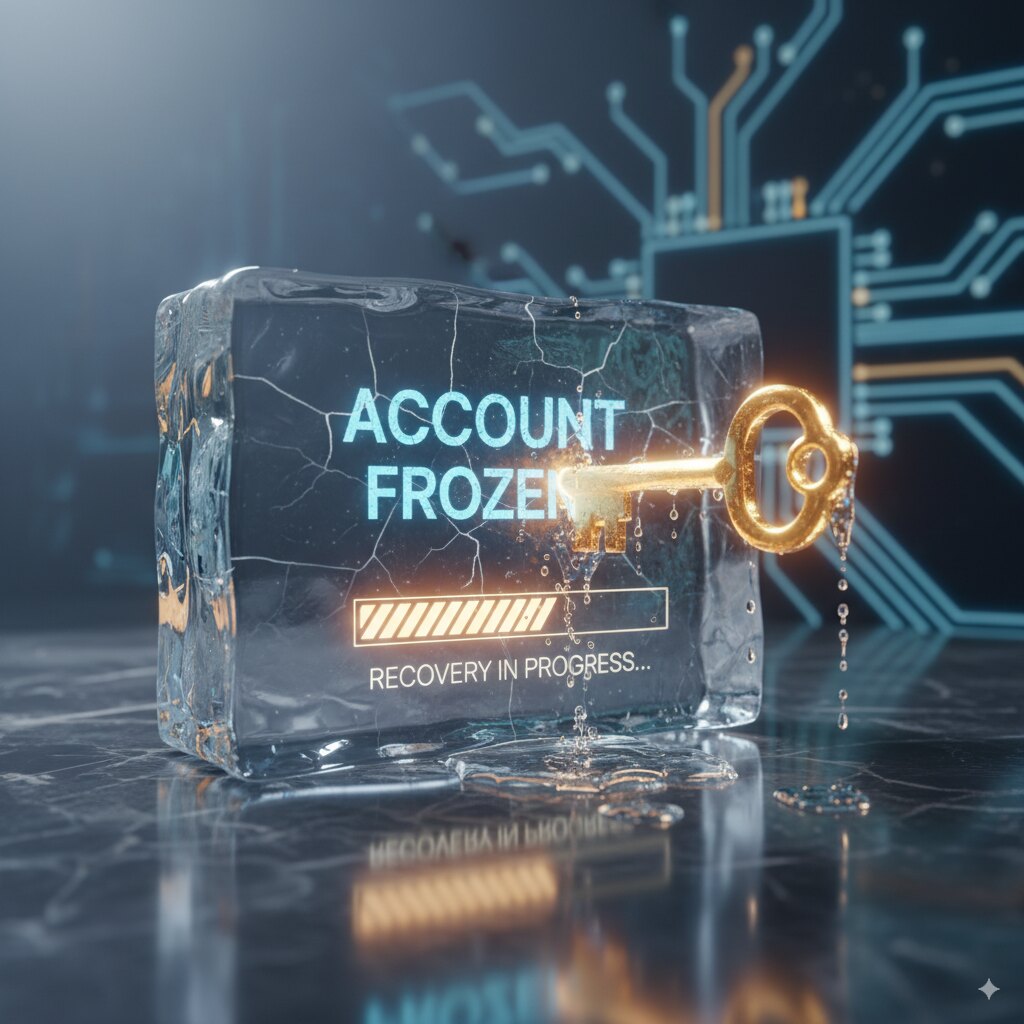
How to Withdraw Money from a Frozen Account: A Professional Guide to Navigating Restrictions
Frozen Account Recovery: The discovery that your bank or financial account has been frozen is a alarming experience, creating immediate financial stress and uncertainty. A common and pressing question arises: How can I withdraw money from a frozen account?
The short, direct answer is that you cannot withdraw funds while an account is actively frozen. The very purpose of a freeze is to restrict all outgoing transactions to protect the funds for a specific reason. However, this does not mean the money is lost. The path to regaining access involves a structured process of resolution, not circumvention.
This article provides a professional, step-by-step guide to understanding the freeze and taking the correct actions to have it lifted, ultimately allowing you to withdraw your money.
1. Understand Why the Account is Frozen
You cannot solve the problem until you know its cause. Institutions freeze accounts for specific, legally-driven reasons. The most common include:
-
Bank Accounts:
-
Suspicious Activity: Unusual transactions that may indicate fraud, money laundering, or structuring (deliberately making transactions under $10,000 to avoid reporting).
-
Creditor Judgment: A court has issued a judgment against you, and a creditor has garnished your account.
-
Government Levy: A state or federal agency (like the IRS for tax debt) has placed a levy on your account.
-
Uncertainty of Ownership: A discrepancy in your personal information or a dispute over the account.
-
-
Cryptocurrency Exchange Accounts:
-
Security Flags: Suspicious login activity or potential unauthorized access.
-
KYC/AML Review: Failure to complete “Know Your Customer” (KYC) verification or the need to confirm the “Source of Funds” for certain deposits or trades.
-
Court Order: As with banks, a legal order can freeze an exchange account.
-
Immediate Action: Check all communication from the institution—email, physical mail, and in-app notifications. They are required to inform you of the freeze and, typically, the general reason behind it.
2. The Step-by-Step Process to Unfreeze an Account (And Then Withdraw)
The goal is not to bypass the freeze but to resolve the underlying issue that caused it. Follow this professional protocol:
Step 1: Contact the Institution Immediately
-
Call the official customer service number or visit a branch in person.
-
Remain calm and professional. Anger or frustration will not speed up the process.
-
Ask specific questions: “What is the exact reason for this freeze?” and “What specific information or documentation do you need from me to resolve this?”
Step 2: Fulfill All Requests for Information
This is the most critical step. Provide everything they ask for promptly and thoroughly. This may include:
-
Proof of Identity: A government-issued photo ID (passport, driver’s license).
-
Proof of Address: A recent utility bill or bank statement.
-
Source of Funds Documentation: This is key for large or suspicious transactions. Be prepared to provide:
-
Bank statements showing the origin of a deposit.
-
Pay stubs or employment contracts.
-
Sale agreements for a vehicle or property.
-
For crypto, transaction histories (TXIDs) from previous, legitimate exchanges.
-
-
A Written Explanation: For any transaction flagged as suspicious, provide a clear, truthful, and concise written statement explaining its purpose.
Step 3: Follow Up Persistently and Document Everything
-
Keep a log of every interaction: dates, times, names of representatives, and what was discussed.
-
If you submit documents via email or a portal, follow up in 3-5 business days to confirm receipt and inquire about the status.
-
Politeness and persistence are your greatest assets.
Step 4: Escalate the Issue if Necessary
If the standard support channel is unresponsive or unhelpful:
-
Ask to speak to a compliance or risk department manager. These teams handle these issues directly.
-
File a formal complaint through the institution’s official complaints procedure.
-
Contact the Relevant Regulator: If the institution is regulated (e.g., a bank by the FDIC or OCC, a crypto exchange by FinCEN), you can file a complaint with that regulatory body. This often triggers a mandated response from the institution.
3. Special Case: Creditor Garnishments or Tax Levies
If the freeze is due to a court order or government levy, the process is different. You typically cannot simply provide documents to the bank to lift it.
-
You must resolve the underlying debt directly with the creditor or the government agency (e.g., the IRS).
-
Once the debt is settled or a payment plan is established, you must obtain a release of levy/garnishment document from the creditor or agency.
-
You must then provide this official release document to your bank to unfreeze the account.
4. What NOT to Do
-
Do NOT attempt to write checks or initiate transfers: These will bounce or be rejected, potentially incurring fees and adding to the confusion.
-
Do NOT ignore the freeze: It will not resolve itself. Proactive engagement is essential.
-
Do NOT provide false information: This will worsen the situation significantly, potentially leading to account closure and legal repercussions.
Conclusion: Patience and Process
Withdrawing money from a frozen account is not an action but an outcome. The outcome of successfully navigating a formal process to have the freeze lifted. There are no quick fixes or secret loopholes.
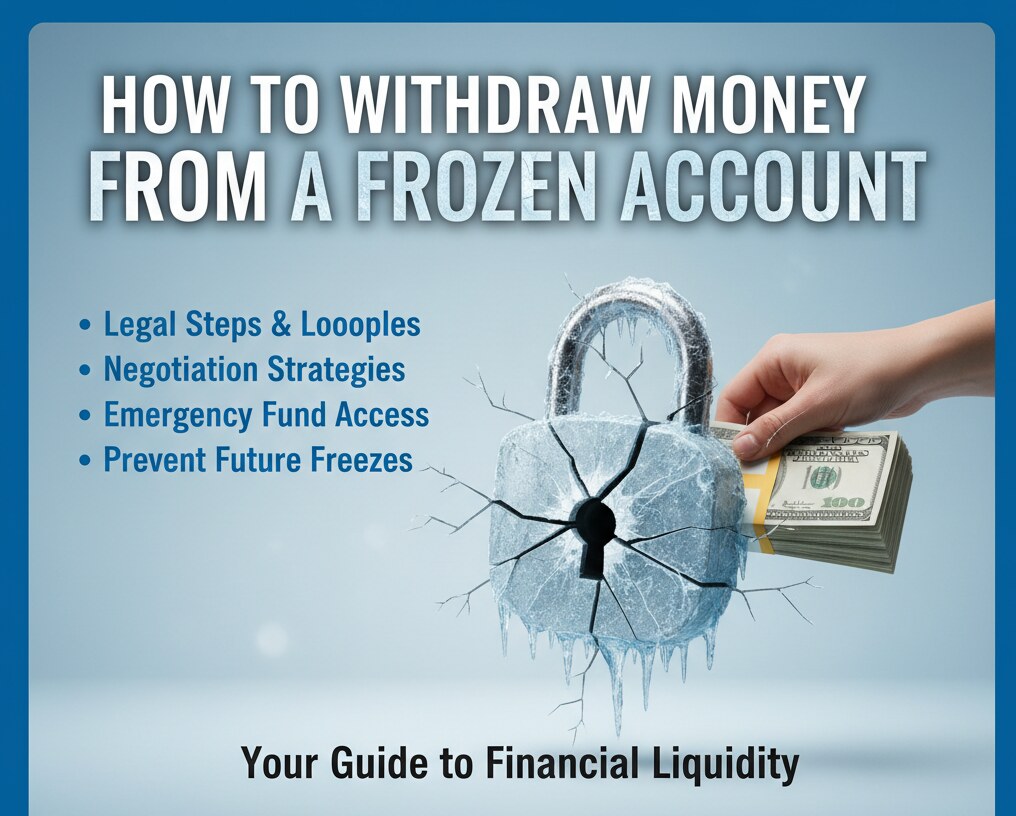
How to Unfreeze a Bank Account: A Professional Guide to Regaining Access
Frozen Account Recovery: A frozen bank account is a serious financial disruption that can halt your ability to pay bills, access wages, and manage daily expenses. While alarming, an account freeze is typically a procedural action taken by your bank to mitigate risk or comply with legal requirements. It is not a permanent seizure, and with the correct approach, it can be resolved.
This article provides a professional, step-by-step guide to understanding why accounts are frozen and the systematic process to unfreeze them.
Phase 1: Diagnosis – Understanding Why Your Account is Frozen
You cannot fix the problem until you know its cause. Banks freeze accounts for specific, legally-driven reasons. The most common include:
-
Suspicious Activity: The bank’s monitoring system has flagged transactions that deviate from your normal pattern. This could be due to:
-
Unusual Large Deposits/Withdrawals: Activity inconsistent with your historical financial behavior.
-
Structuring: Making multiple transactions just under the $10,000 threshold to avoid Currency Transaction Reports (CTRs), which is illegal.
-
Potential Fraud: Evidence suggesting the account may be compromised or used for fraudulent purposes.
-
-
Debt Collection (Garnishment): A creditor has won a lawsuit against you and obtained a court order to garnish your funds. Government agencies like the IRS can also levy accounts for unpaid taxes.
-
Identity Verification Issues: The bank may need to reconfirm your identity due to:
-
Expired KYC Information: An outdated driver’s license or address on file.
-
Inconsistent Information: Discrepancies in your personal details across different accounts.
-
-
Court Order: A judge may freeze an account due to an ongoing investigation, a dispute (e.g., a divorce proceeding), or other legal matters.
Your First Action: Immediately check your email, physical mail, and online banking portal for notifications. The bank is almost always obligated to inform you of the freeze and the general reason behind it.
Phase 2: The Action Plan – A Step-by-Step Process to Unfreeze Your Account
Resolving a freeze requires a calm, organized, and persistent approach.
Step 1: Contact Your Bank Directly
-
Call the customer service number on the back of your debit card or on the bank’s official website. For complex issues, visiting a branch in person can be more effective.
-
Remain calm and professional. State clearly that you have received notice of a frozen account and are seeking to resolve it.
-
Ask the critical questions: “What is the specific reason for this freeze?” and “What exact information or documentation do you need from me to lift it?”
-
Document every interaction: Note the date, time, representative’s name, and case/reference number.
Step 2: Gather and Submit Requested Documentation
This is the most crucial step. Provide exactly what they ask for, promptly and thoroughly. Commonly requested items include:
-
Proof of Identity: A valid government-issued photo ID (passport, driver’s license).
-
Proof of Address: A recent utility bill, lease agreement, or bank statement.
-
Source of Funds Documentation (For Suspicious Activity): This is essential for explaining large or unusual transactions. Be prepared to provide:
-
Pay stubs or employment contracts.
-
Bank statements from another account showing the transfer origin.
-
Invoices, sale agreements, or contracts explaining a large deposit (e.g., from selling a car).
-
Tax returns (for large, periodic deposits).
-
Step 3: Provide a Clear Explanation
If the freeze is due to a specific transaction, you may need to provide a signed, written statement explaining the nature and purpose of that transaction. Be clear, concise, and truthful.
Step 4: Follow Up Diligently
-
After submitting documents, follow up within 3-5 business days to confirm receipt and check on the status of your case.
-
Politeness and persistence are key. If the frontline representative cannot help, politely ask to speak to a manager in the compliance or risk department, as they handle these issues directly.
Step 5: Escalate if Necessary
If the bank is unresponsive or the issue remains unresolved after repeated attempts:
-
File a formal complaint through the bank’s official complaints channel.
-
Contact the Bank’s Regulator: If the bank is federally chartered, you can file a complaint with the Office of the Comptroller of the Currency (OCC). For state-chartered banks, contact your state’s banking regulator. You can also file with the Consumer Financial Protection Bureau (CFPB). This often triggers a mandated response from the bank.
Special Consideration: Garnishments and Levies
If the freeze is due to a creditor garnishment or tax levy, the process is different. You must resolve the underlying debt.
-
Contact the creditor or the government agency (e.g., the IRS) directly to settle the debt or establish a payment plan.
-
Once resolved, you must obtain a “Release of Levy” or similar court document.
-
Provide this official release to your bank to unfreeze the account.
What to Avoid
-
Do Not attempt to write checks or make payments from the frozen account, as they will be rejected, potentially causing further issues.
-
Do Not ignore the freeze; it will not resolve itself.
-
Do Not provide false or misleading information, as this will severely worsen the situation.
Conclusion: Resolution Through Process
Unfreezing a bank account is rarely a quick process, but it is a manageable one. The key to success lies in a professional and systematic approach: understanding the root cause, providing impeccable documentation, and maintaining persistent, polite communication with the bank.
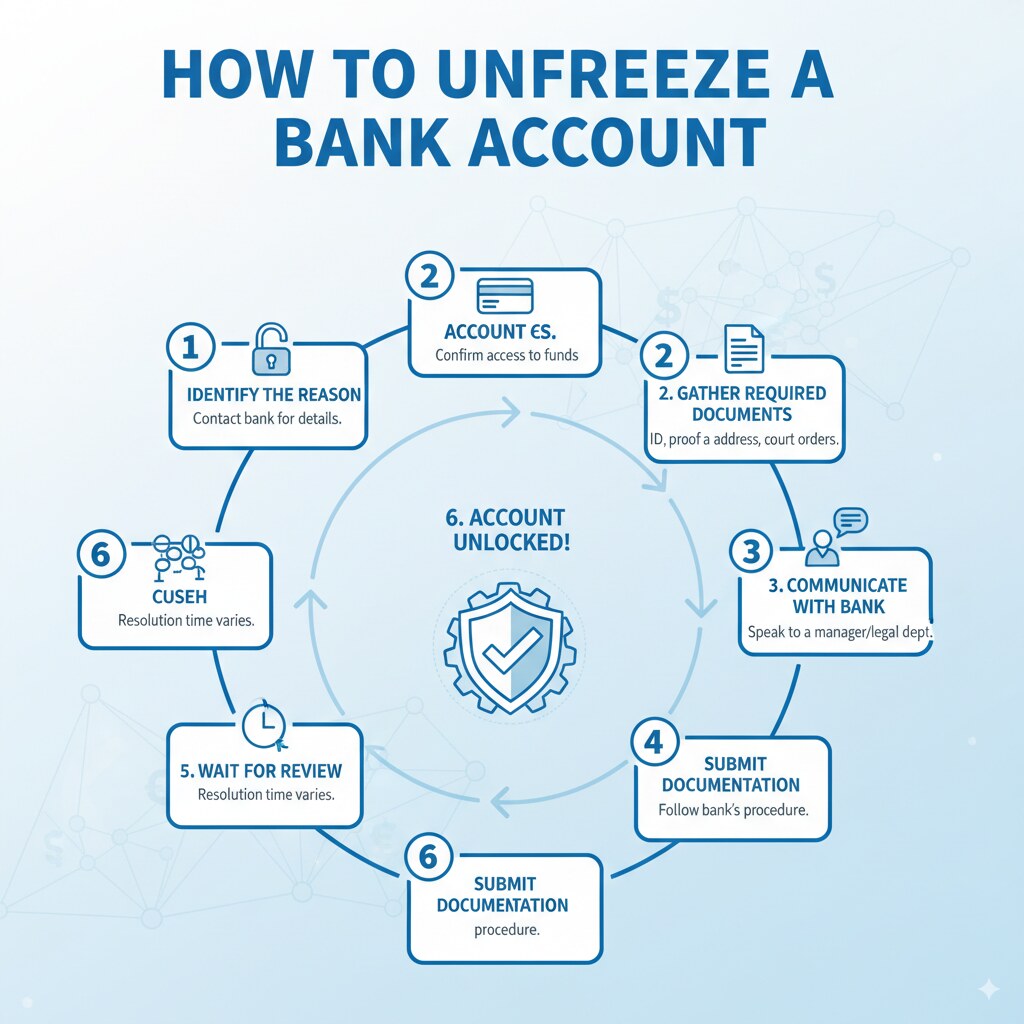
Frozen Account Recovery for Fake Investment Platforms: A Strategic Guide to Potential Asset Recapture
Frozen Account Recovery: Falling victim to a fake investment platform is a devastating experience, compounded by financial loss and a sense of violation. In the complex aftermath, a critical window of opportunity may emerge: the possibility of frozen account recovery. This does not refer to your account being frozen, but to the potential freezing of the scammers’ accounts by authorities or financial institutions, creating a pathway to recapture some of your lost funds.
This article provides a professional, strategic guide to navigating this precarious situation, outlining the actions that can lead to recovery and managing expectations throughout the process.
Understanding the “Frozen Account” in This Context
When a fake investment platform is exposed, two scenarios involving “frozen accounts” can occur:
-
The Scammers’ Accounts are Frozen: Law enforcement or a regulatory agency, upon investigating the platform, may successfully petition to freeze the bank or cryptocurrency exchange accounts holding the victims’ funds. This prevents scammers from laundering and dissipating the money.
-
Your Account on the Platform is “Frozen”: The scammers themselves may falsely claim your account is “frozen” for a fee (e.g., demanding a “tax” or “release fee” to withdraw your “profits”). This is always a secondary scam designed to extract more money from you. There are no profits, and paying will only increase your loss.
This guide focuses on the first scenario—legitimate recovery through official action.
The Recovery Process: A Multi-Front Strategy
Recovering funds from a fake platform is not a do-it-yourself task. It requires engaging with professional entities and following a formal process.
Phase 1: Immediate Action and Documentation
Time is of the essence. As soon as you suspect you are a victim, begin this process:
-
Cease All Communication: Stop engaging with the platform or its representatives. Do not pay any “fees” they demand.
-
Gather Comprehensive Evidence: This is your most important tool. Compile:
-
Platform Details: The website URL, company name, and contact information.
-
All Communication: Screenshots of chats, emails, and phone numbers.
-
Transaction Records: Bank statements, credit card transactions, and cryptocurrency transaction IDs (TXIDs) showing all deposits.
-
Proof of Identity Used: Any copies of passports or driver’s licenses you may have sent to the scammers.
-
-
Secure Your Own Accounts: Immediately contact your bank and credit card company. Report the fraudulent transactions. You may be able to reverse credit card payments through a chargeback if acted upon quickly. For wire transfers or cryptocurrency transfers, recovery is more complex but still requires notifying your bank or exchange.
Phase 2: Official Reporting – The Engine of Recovery
The only way to trigger a genuine account freeze is through official channels. Your reports provide the evidence authorities need to act.
-
Report to Law Enforcement:
-
Local Police: File a report with your local police department. Obtain a copy of the report.
-
Federal Agencies (U.S.): File a detailed report with the Federal Bureau of Investigation’s Internet Crime Complaint Center (IC3). The IC3 aggregates data that can lead to large-scale investigations.
-
Financial Regulators: Report the platform to the Securities and Exchange Commission (SEC) or the Commodity Futures Trading Commission (CFTC), which have the authority to investigate and shut down fraudulent investment schemes.
-
-
Report to Financial Institutions:
-
Your Bank/Credit Card Company: As mentioned, this can initiate a fraud investigation and chargeback process.
-
The Scammers’ Bank/Exchange (If Known): If you can identify which bank or cryptocurrency exchange received your funds (e.g., from your bank statement or blockchain analysis), you can file a report directly with their fraud and compliance department. They can freeze the recipient account if they confirm fraudulent activity.
-
Phase 3: The Role of Asset Recovery Firms (Proceed with Caution)
Some private firms specialize in tracing and recovering stolen funds. If you consider this route, extreme diligence is required.
-
How They Can Help: Legitimate firms use blockchain forensics to trace crypto funds and have established relationships with exchanges to submit evidence for freezing scams.
-
Massive Red Flags: Avoid any firm that:
-
Guarantees recovery.
-
Demands large upfront fees.
-
Contacts you first via social media or email.
-
Asks for your private keys or sensitive financial information.
-
-
Best Practice: Only engage firms that work on a contingency fee basis (they take a percentage of recovered funds only upon success) and have verifiable credentials and testimonials.
Managing Expectations: The Realities of Recovery
It is crucial to understand the challenges:
-
Low Success Rate: Recovery is never guaranteed. Scammers are adept at quickly moving and laundering funds across borders through complex networks.
-
Time-Consuming: Investigations and legal proceedings can take months or even years.
-
No Central Authority: Unlike FDIC insurance for banks, there is no insurance for funds lost to fraud on unregulated platforms.
-
Partial Recovery: Even successful efforts often result in only a partial return of funds after legal fees and administrative costs.
Conclusion: A Race Against Time
Recovering funds from a fake investment platform is a difficult race against time. The probability of success hinges on the speed of your response, the quality of your evidence, and the ability of authorities to locate and freeze the scammers’ accounts before the money is gone.
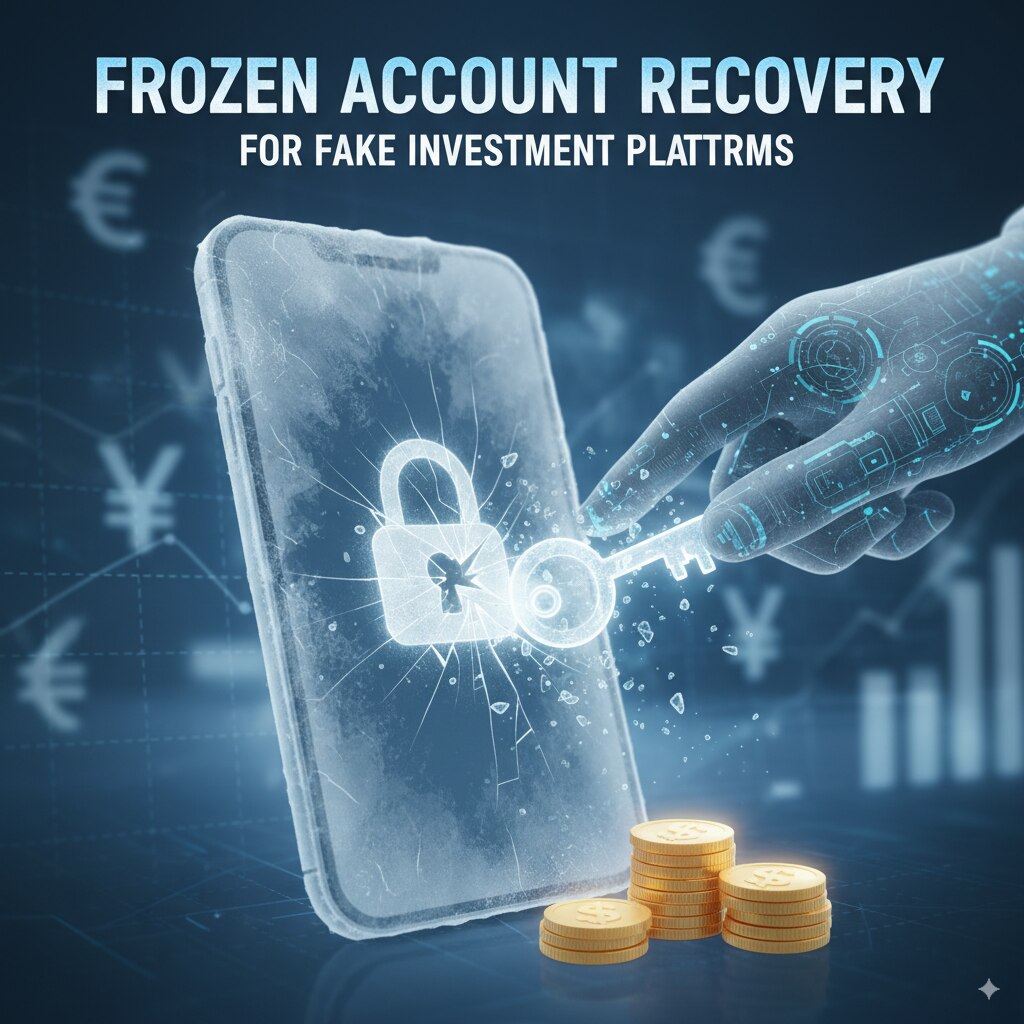
How to Withdraw Money from a Frozen Account Online: A Professional Guide
Frozen Account Recovery: Discovering your account is frozen creates immediate financial stress. This guide provides a clear, professional pathway to resolve the issue and regain access to your funds.
The Direct Answer: You cannot withdraw funds from an account while it is frozen. The restriction is designed to prevent any movement of assets. The solution is not to bypass the freeze but to resolve the underlying cause through official channels.
Quick-Reference Guide: Account Freeze Causes & Resolution
| Cause of Freeze | Recommended Digital Action | Expected Outcome & Timeline |
|---|---|---|
| Security & Fraud Alert | 1. Check for bank alerts in your app/portal. 2. Verify your identity via secure messaging. |
Often resolved within 24-48 hours after verification. |
| KYC/AML Compliance Hold | 1. Use the “Document Upload” section. 2. Submit required IDs and Proof of Address. |
3-5 business days for compliance team review. |
| Disputed Transaction | 1. Use secure messaging to contact the dispute department. 2. Provide evidence (e.g., receipt). |
Can take 30-90 days depending on the case. |
| Court Order or Levy | *Digital resolution is often not possible.* 1. Contact the issuing authority (e.g., court, IRS). 2. Obtain a “Release of Levy” document. |
Timeline varies significantly based on the legal case. |
Step-by-Step Digital Resolution Process
-
Identify the Cause: Log into your online portal or mobile app immediately. Check for secure messages and notifications.
-
Use Official Digital Channels:
-
Secure Messaging: This is your primary tool. It creates a documented audit trail.
-
Document Upload Portal: Use the bank’s secure upload feature to submit requested files.
-
Live Chat / Virtual Appointment: For real-time help, use these verified functions.
-
-
Provide Requested Documentation: Be prepared to submit digital copies of:
-
Government-issued Photo ID
-
Proof of Address (utility bill, bank statement)
-
Source of Funds documentation (pay stubs, tax returns)
-
-
Follow Up and Escalate: If there is no response within 5 business days, send a polite follow-up message. Ask to have your case escalated to the compliance or risk department.
⚠️ Critical Warning: Avoid Recovery Scams
Be aware of these red flags:
-
Unsolicited Contact: Anyone calling, emailing, or texting you out of the blue claiming to be a “recovery agent” is a scammer.
-
Requests for Fees or Keys: A legitimate entity will never ask for an upfront fee, your online banking password, or your cryptocurrency private keys.
-
Too-Good-To-Be-True Promises: Guarantees of 100% success or instant recovery are false.
Top Resources for Further Reading
-
Comprehensive Guide to Frozen Account Recovery
-
How to Spot and Avoid Phishing Scams
-
Understanding KYC & AML: What Financial Institutions Need
-
Step-by-Step: How to File a Formal Complaint with a Bank Regulator
-
USA.gov – How to Report Financial Fraud
-
Federal Trade Commission (FTC) – Recovery Scams
-
Consumer Financial Protection Bureau (CFPB) – Submit a Complaint
-
Office of the Comptroller of the Currency (OCC) – HelpWithMyBank.gov
Conclusion
Withdrawing from a frozen account online is not possible until the freeze is lifted. Success depends on a calm, methodical approach: using official digital channels to communicate, providing impeccable documentation, and following up diligently. By understanding the process and avoiding scams, you can efficiently navigate this challenge and restore your financial access.
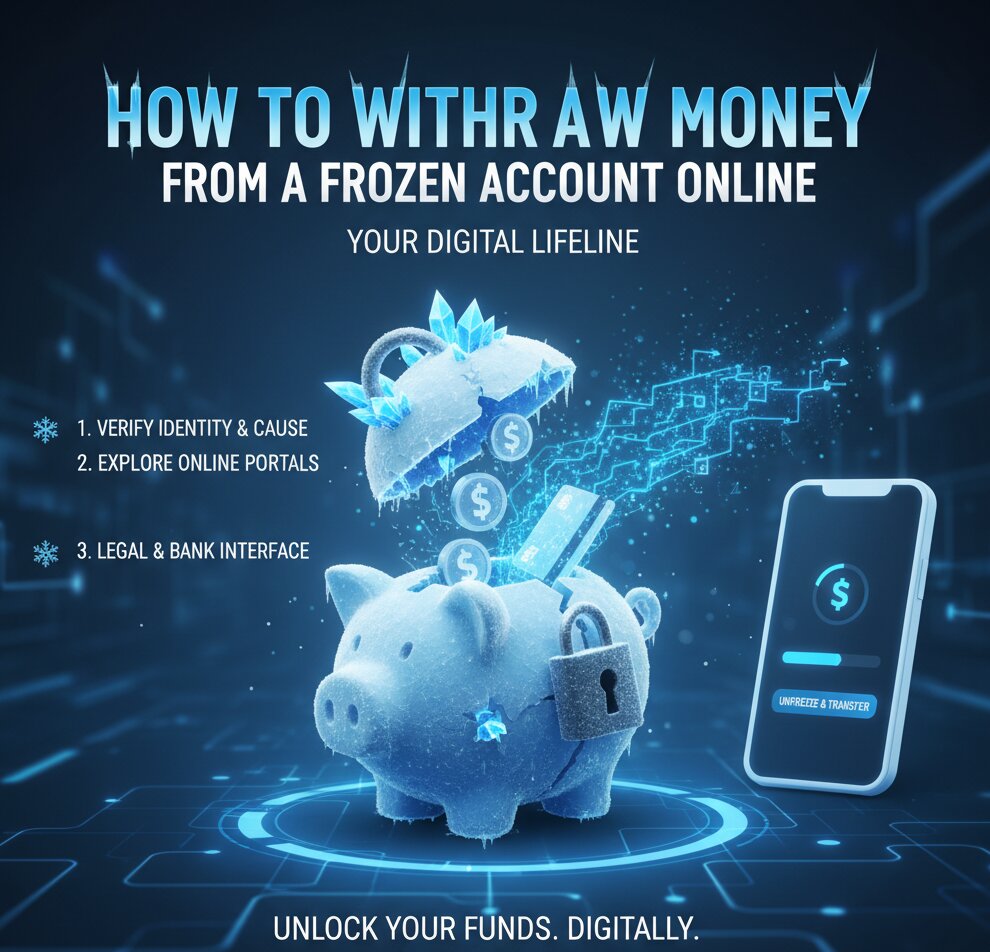
Cryptocurrency Frozen Account Recovery: A Strategic Guide to Regaining Access
Frozen Account Recovery: In the world of cryptocurrency, the concept of a “frozen account” primarily applies to funds held on centralized exchanges (CEXs) like Coinbase, Binance, or Kraken. Unlike the immutable nature of a blockchain itself, these platforms operate as regulated intermediaries and have the authority to restrict account activity for compliance, security, or legal reasons. A frozen account halts withdrawals, trading, and sometimes deposits, creating significant anxiety for users.
This article provides a professional, strategic framework for understanding why cryptocurrency accounts are frozen and the systematic process for recovering access to your assets.
Understanding the Why: Common Reasons for Freezes
Exchanges freeze accounts to mitigate risk and comply with global regulations. The most common triggers include:
-
Security and Suspicious Activity Flags: The exchange’s automated systems detect unusual activity, such as logins from new geographic locations, transactions patterns suggesting market manipulation, or potential unauthorized access.
-
Know Your Customer (KYC) and Anti-Money Laundering (AML) Reviews: This is the most frequent cause. It can be triggered by:
-
Incomplete Verification: Failure to complete mandatory KYC steps.
-
Source of Funds (SoF) / Source of Wealth (SoW) Checks: The exchange requires documentation to verify the origin of large deposits or trades to prevent money laundering.
-
Expired Documentation: A government-issued ID on file has expired.
-
-
Disputed Transactions: A chargeback on a fiat deposit (e.g., a reversed credit card payment or bank transfer) can lead to a freeze on the corresponding crypto assets.
-
Legal and Regulatory Orders: A court order, subpoena, or injunction from a government agency can legally compel an exchange to freeze an account pending an investigation.
The Recovery Process: A Step-by-Step Action Plan
Resolving a frozen account requires a calm, organized, and persistent approach. Follow these steps methodically:
Phase 1: Immediate Diagnosis and Documentation
-
Do Not Panic: A freeze is often a standard procedural issue, not a permanent seizure.
-
Check Official Notifications: Log into your exchange account and check all notification centers, support tickets, and associated email addresses. The exchange is required to communicate the reason for the freeze, though the message may be generic (e.g., “security review”).
-
Gather Evidence: Prepare digital copies of relevant documents. This typically includes:
-
Proof of Identity: A valid government-issued photo ID (passport, driver’s license).
-
Proof of Address: A recent utility bill or bank statement (less than 3 months old).
-
Source of Funds (SoF): This is critical. For fiat deposits, provide bank statements. For cryptocurrency deposits, provide transaction IDs (TXIDs) from the sending wallet or exchange to prove a legitimate origin.
-
Phase 2: Strategic Engagement with the Exchange
-
Use Official Channels Only: Contact support exclusively through the exchange’s official website or app. Never engage with “support” that contacts you first on Telegram, Twitter, or other social media—this is a common recovery scam.
-
Submit a Clear, Professional Ticket: When opening a support ticket, be concise and professional.
-
Subject Line: “Formal Inquiry Regarding Frozen Account: [Your Account Email]”
-
Body: State that your account has been restricted, mention any ticket/reference numbers from notifications you received, and politely ask for the specific reason and the exact list of documents required for resolution.
-
-
Upload Requested Documents Securely: Use the exchange’s secure portal for document submission. Never send sensitive KYC documents via unencrypted email.
-
Provide a Transaction Explanation (If Required): For specific flagged transactions, you may need to provide a clear, truthful written explanation of their purpose and nature.
Phase 3: Diligent Follow-Up and Escalation
-
Allow Time for Review: Compliance teams handle high volumes. Allow 3-5 business days for a response after submission.
-
Follow Up Politely: If you receive no response, reply to your existing support ticket to politely ask for an update. Avoid opening duplicate tickets, as this can slow the process.
-
Formal Escalation: If the issue remains unresolved for weeks, use the exchange’s official complaints procedure. As a last resort, you can file a complaint with the relevant financial regulator in the exchange’s home jurisdiction (e.g., FinCEN in the U.S.).
What to Avoid: Critical Red Flags
-
Recovery Scams: Ignore any individual or service that promises guaranteed recovery for an upfront fee. They will steal your money and/or credentials.
-
Sharing Private Keys: An exchange will never ask for your private keys or seed phrases. Anyone who does is a scammer.
-
Public Outbursts: Avoid venting frustrations on social media; it rarely helps and may attract scammers. Keep communications professional and private.
Prevention: The Ultimate Recovery Strategy
The best way to handle a frozen account is to prevent it from happening.
-
Complete Full KYC Proactively: Before conducting large transactions, ensure your verification is 100% complete and your documents are up-to-date.
-
Maintain Transaction Records: Keep meticulous records of all fiat and crypto transactions, including TXIDs and bank statements.
-
Use Self-Custody for Large Sums: For significant long-term holdings, transfer assets to a private hardware wallet. “Not your keys, not your coins” remains the foundational principle of security and control. Exchanges are for trading; wallets are for storing.
Conclusion
Recovering a frozen cryptocurrency exchange account is a test of patience and procedure. It is rarely a quick process, but by understanding the compliance-driven reasons behind freezes, responding promptly with impeccable documentation, and communicating professionally through official channels, you can significantly increase your chances of a successful resolution.




